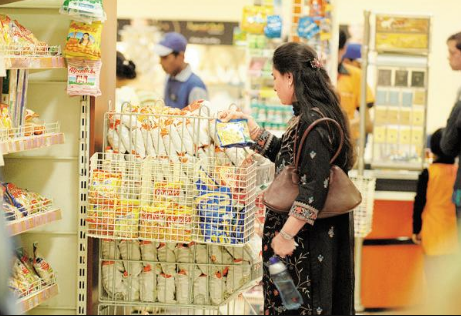 Consumers across developed and developing markets have shown significant preference for e-commerce and continue to embrace online shopping to address their growing need for convenience, better pricing, product assortment and ease of delivery. In Asia Pacific 43% consumers surveyed by Nielsen are already using e-commerce platforms for home delivery of products. Similarly, 25% of consumers in Africa and Middle East, followed by 20% in Latin America are already buying products online for home delivery.
Consumers across developed and developing markets have shown significant preference for e-commerce and continue to embrace online shopping to address their growing need for convenience, better pricing, product assortment and ease of delivery. In Asia Pacific 43% consumers surveyed by Nielsen are already using e-commerce platforms for home delivery of products. Similarly, 25% of consumers in Africa and Middle East, followed by 20% in Latin America are already buying products online for home delivery.
With rising consumer uptake across e-commerce categories, online FMCG growth is accelerating across the globe. In fact, our Future Opportunities in FMCG E-commerce study estimates that online FMCG growth will accelerate four times faster growth than offline sales in the next five years.
Consumers’ buying habits are shifting toward online, and their changing product preferences have created the need for FMCG companies to address demand and consider FMCG e-commerce integral to their overall business strategies. However, some barriers that pose challenges ahead of established brick-and-mortar businesses: handling perishable products and limited shelf life of FMCG products, scaling up the online model beyond few markets, lack of infrastructure to support delivery solutions, and regulatory framework compliance.
Our report identifies 10 key drivers that explain current FMCG e-commerce success in 34 markets globally. Markets with supporting drivers for such as high population density, a pro-business landscape, postal reliability, internet penetration and a savings-conscious society will enjoy greater online FMCG success.
Many countries in Asia, for example, are setting the pace for online FMCG growth, thanks to the presence of large e-commerce brands, innovations in technology, investments in infrastructure, smartphone penetration and increased consumer demand. South Korea is leading the way in e-commerce globally, with nearly one-fifth (18%) of all FMCG sold via online channels, closely followed by China (16% of FMCG sold online). We expect European markets to provide some growth opportunities for online FMCG over the next five years, with more than a quarter of consumers (26%) there already using e-commerce services for home delivery of products.
In Europe, the FMCG online growth is expected on account of ageing population (older generations will prefer to have items delivered), consumers experiencing changes in work-life dynamics, increasing congestion, urbanization and growing need for convenience. U.K. is leading the total share of FMCG online sales (6.3%), closely followed by France (6.1% of FMCG sold online) that has a nationwide click-and-collect e-commerce model since early 2000s making e-commerce successful despite low population density. In some other markets such as India, Brazil, Russia and Greece the key drivers indicate poor threshold value and hence they demonstrate lower percentages of FMCG online sales.
Here is a snapshot of how online FMCG sales compares across few global markets based on 10 key drivers.

Strong Infrastructures Are Needed For FMCG E-Commerce Growth
We expect online FMCG sales to double globally over the next five years; growth will be twice as fast in developing markets than in developed markets. For FMCG e-commerce to thrive, markets must have foundational infrastructures in place, such as high penetration levels for bank accounts, mobile payments, internet access and smartphone uptake.
“Many consumers across Asia-Pacific have experienced online shopping in some form, be it travel, apparel, electronics or other similar categories,” notes Ji Hyuk Park, Nielsen’s Developed Markets Digital Retail Lead at Nielsen. “Developing markets across the region hold much promise for rapid FMCG e-commerce growth in the coming years as consumers make the leap from traditional trade to online marketplace, making the need for omni-channel offerings more critical than ever for FMCG retailers.”
The future potential of FMCG e-commerce depends upon three important levers: favorable megatrends, strategic investment landscape, and technology & innovation in their respective markets. An example of rise in online consumption is Colombia, wherein multiple new investments are being made along with the rise of startup companies addressing consumers’ demand for online FMCG to avoid multiple shopping trips to brick and mortar grocery stores. It is estimated that connected spenders will increase their total consumption from US$29 billion in 2015 to US$105 billion by 2025. Our report estimates that Colombia’s e-commerce share of total FMCG value will be worth US$307 million by 2022.
In United Arab Emirates (UAE) internet penetration, smartphone usage and business infrastructure support consumer uptake of online FMCG. Our report estimates UAE’s e-commerce share of total FMCG value in 2022 will be worth US$112 million.
Regardless of the geographical presence of a company, it’s consumers today are seeking online platforms to satisfy their product needs and embrace new solutions to simply their lifestyles. It becomes necessary to understand the success drivers for e-commerce in a given market and also examine deep insights to assess the future potential of the market.


